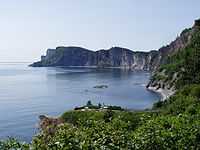Forillon National Park
| Forillon National Park | |
|---|---|
|
IUCN category II (national park) | |
|
Cap Gaspé at sunset | |
 Location of Forillon National Park | |
| Location | Gaspé, La Côte-de-Gaspé Regional County Municipality, Quebec, Canada |
| Nearest city | Gaspé, Quebec |
| Coordinates | 48°54′N 64°21′W / 48.900°N 64.350°WCoordinates: 48°54′N 64°21′W / 48.900°N 64.350°W |
| Area | 244 km2 (94 sq mi) |
| Established | 1970 |
| Visitors | 137,070 (in 2007[1]) |
| Governing body | Parks Canada |
Forillon National Park, one of 42 national parks and park reserves across Canada, is located at the outer tip of the Gaspé Peninsula of Quebec and covers 244 km2 (94 sq mi).[2] Created in 1970, Forillon was the first national park in Quebec. The park includes forests, sea coast, salt marshes, sand dunes, cliffs, and the Eastern End of the Appalachians. The park includes nesting colonies of sea birds and whales, seals, black bears, moose, and other woodland animals. The word forillon is thought to have referred to a flowerpot island or sea stack which used to be a landmark in the area but has since collapsed into the ocean.
History of the area
The area was a traditional summer hunting and fishing ground for the Micmac and Iroquois.[3]
The creation of the park
The creation of the Park in 1970 was preceded by the removal through expropriation of approximately 100 families that had settled within the boundaries of the proposed area. Several of the foundations of the demolished houses remain today hidden in the underbrush of several sections of the park. Several families in the Gaspé Peninsula region were forced to re-settle in the surrounding areas and hold a vivid memory of the events that unfolded during those times. Forillon National Park does not mention these events anywhere within their exhibits and fails to acknowledge the existence of a community within the park. When preparing to create the new park, the Government of Canada requested that the Quebec government expropriate the homes of these families. The Quebec government sub-contracted the appropriation and negotiations to a private firm. This firm allegedly used various bullying tactics to scare the residents into agreeing to settlements of reduced value. This stratagem ensured a larger profit margin for the contractor.[4] On February 14, 2011 the House of Commons adopted a motion which issued an official apology to the people whose properties were expropriated to create Forillon Park.[5] The motion read:
That this House issue an official apology to the people whose properties were expropriated to create Forillon Park for the unconscionable manner in which they were treated, and that the Speaker of the House send the representatives of the people whose properties were expropriated and of their descendants an official copy of the Journals of the House of Commons indicating the adoption of this motion.
Activities and sights
Activities at interpretation sites bring visitors to learn more about human and natural life in the Forillon peninsula. The Grande-Grave National Heritage Site attests to the way of life of fishing families.[6] The Hyman Store features collections of articles that were sold at the time, and the store "owners" tell tales of thriving fisheries industry. Close by, the pedestrian walk "Une Tournée dans les Parages" brings visitors around houses, fields and agricultural and commercial installations from the beginning of the twentieth century.
Forillon encloses the site of Fort Péninsule, near the Penouille beach. This fortification was built during World War II to protect the Gaspé bay, as was Fort Prével on the other side of the bay; had Germany conquered all of Europe, these forts would have sheltered British warships seeking refuge from German submarines. Visitors today can enter an underground tunnel to see cannon in place since that time.
Gallery
-

Panoramic view from Mount Saint-Alban
-

Cap Gaspé taken from Cap Bon-Ami, on the North side of the Forillon peninsula
-

The peninsula leading to Cap Gaspé in Forillon National Park, taken from Mont Saint-Alban
-

Rock formation called "Le Vieux" (the Old Man) and Cap Gaspé lighthouse
-

Tallest lighthouse in Canada at Park Forillon
-

Reproduction of a traditional salt cod fishery installation created for the 1998 TV series, "L'ombre de l'épervier"
-

Stepped cascade along the "La Chute" hiking trail
-

Waterfall along the "La Chute" hiking trail
-

Water splashing over mossy rocks. Close-up of waterfall along the "La Chute" hiking trail
-

Harbour seal (Phoca vitulina) near Cap Gaspé
-

Double-crested cormorants (Phalacrocorax auritus) near Cap Bon-Ami
-

Grey seals (Halichoerus grypus) near Cap Bon-Ami
-

North American porcupine (Erethizon dorsatum) at Cap Gaspé

See also
| Wikimedia Commons has media related to Forillon National Park of Canada. |
- National Parks of Canada
- List of National Parks of Canada
- List of Quebec national parks
References
- ↑ "Parks Canada Attendance 2003-04 to 2007-08" (PDF). Parks Canada. 2008. Retrieved 2009-04-04.
- ↑ http://www.pc.gc.ca/eng/pn-np/qc/forillon/index.aspx
- ↑ http://www.thecanadianencyclopedia.com/index.cfm?PgNm=TCE&Params=A1ARTA0002915
- ↑ http://openparliament.ca/bills/votes/1072/
- ↑ http://openparliament.ca/bills/votes/1072/
- ↑ http://www.pc.gc.ca/eng/pn-np/qc/forillon/index.aspx
External links
| ||||||||||||||||||||||||||
